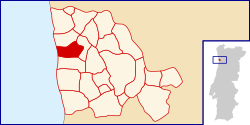Valadares (Vila Nova de Gaia)
| Valadares | |
|---|---|
| Parish | |
 |
|
| Country | Portugal |
| Municipality | Vila Nova de Gaia |
| Disbanded | 2013 |
| Area | |
| • Total | 5.14 km2 (1.98 sq mi) |
| Population (2011) | |
| • Total | 10,678 |
| • Density | 2,100/km2 (5,400/sq mi) |
| Website | http://www.freguesiavaladares.com/ |
Valadares is a former civil parish in the municipality of Vila Nova de Gaia, Portugal. In 2013, the parish merged into the new parish Gulpilhares e Valadares. The population in 2011 was 10,678, in an area of 5.14 km².
Today the shoreside vicinity is very popular for its nightlife and the bars along its well-known beach. It is also possible to see some old sanatoriums used mostly in the 1940s and 1950s to treat people suffering from bone fractures and diseases like tuberculosis. The sanatoriums were established here because the region is extremely rich in iodine, valuable for its antiseptic uses in medicine.
Valadares is also very famous for Cerâmica de Valadares that today it is considered the biggest and most varied National Manufacture provider of sanitary ware and ceramic fittings. There is a train station.
The coat of arms are made up of a ceramic vase on the center with a dentate wheel behind, on the left is maize and on the right a shield over the water, on the bottom is water. The flag has two white and two blue squares.
The ceramic vase with a dentate wheel represents the ceramic industry and the archaeological findings. The maize represents the fields in Vila Chá. The shield represents the shields of Vila Nova de Gaia coat of arms. The water represents the ocean and the beach of Valadares. The colors blue and white represent the ocean and foam of the waves.
The name Valadares originates from the word "Vallado", that means obstacle. That may be the "Crasto de Valadares" a fortification from the second period of the Iron Age (450 b.C.). This "Crastos" on the northwest of Iberian Peninsula, goes from the 5th century B.C. to AD 5th century. In the Middle Ages, Valadares belonged to the Monastery of Grijó. During the first half of the 20th century, Valadares enjoyed a considerable development, being one of the most developed parishes of Gaia, due the existence of the Cerâmica de Valadares, one important Train Station, Sanatoriums, several Schools and a theatre (Cine-teatro Eduardo Brazão).
...
Wikipedia
